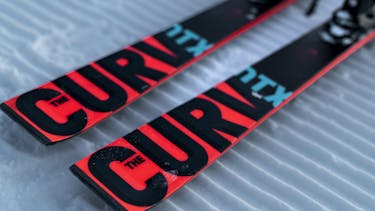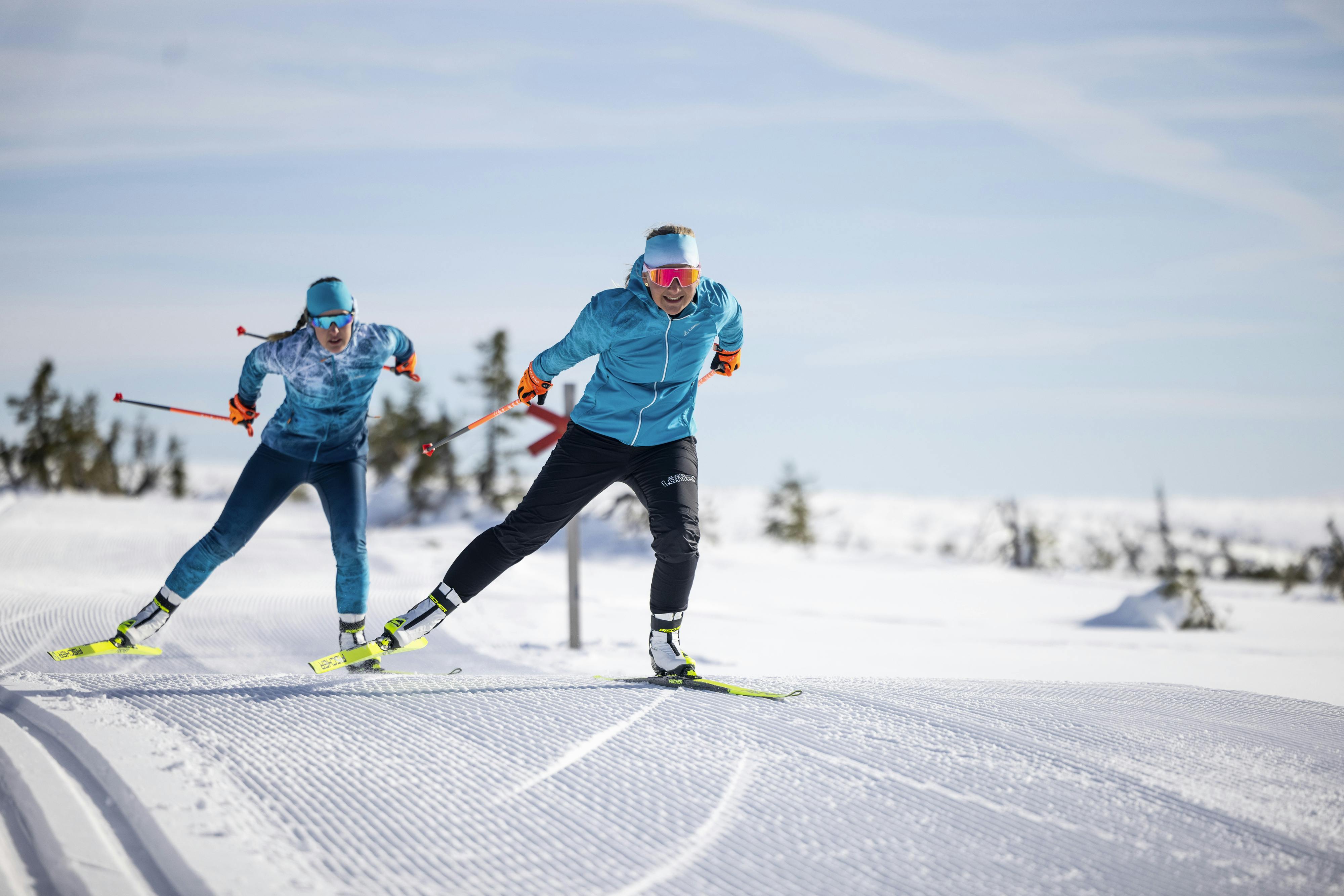Beginner ski versus advanced ski
First of all, if it's your very first ski season, you don't need the crème de la crème among the ski models. As an absolute newbie you'll probably have a very hard time wearing a world cup ski and thus ruin your own fun. If you recognize yourself in the following characteristics, you fall into the category beginners:
- cautious driving style, low to medium speed
- sliding down on paved slopes
- rather doing pleasure rides with long swings
- reserved skiing in difficult snow/bad weather conditions
Nah, way too boring, you are thinking? Then you're probably not a newbie anymore and could refer to yourself as an advanced skier. In other words:
- You got some experience on skis.
- You are on the move even if it is not the "perfect skiing day", i.e. when it is snowing, foggy, etc.
- You are always out to improve your technique and become faster.
And what are those differences between skis that fit these respective levels? Simply speaking: Advanced skiers (tend to) ride on longer boards. Depending on the area of use, professional skis also have stronger or weaker waists. The terms waist and flex are still completely new territory for you? Then we'd better start all over again - which ski suits the beginner level best?
Test for beginners: Which ski works best for me?
Whether a ski really is like chalk and cheese or causes frustrating days on the slopes depends essentially on three factors:
✓ Skiing ability
✓ Planned field of use
✓ Body size and weight
If you realistically assess these aspects, you are on your way to get the ideal pair of skis. The emphasis is on realistically. Wrong pride or the conviction "I'm sure I'll learn it fast" won't do you much good on the slope - if you get on with a ski that's one size too big for your experience level, you'll notice it sooner rather than later. There has to be at least that much honesty at this point.
Just have a look at the following table - where do you see yourself most likely?
| Absolute beginners | Beginners with some experience | Advanced | Very advanced | |
|---|---|---|---|---|
| Style & skills | Rather cautious and slow, technique still to be learned, only occasional skiing | Basics are already mastered confidently; medium-fast speed | Competent, performance-oriented; fast skiing (On-piste) | Extremely performance-oriented, professional driving style & good technique |
| Where are you skiing? | On-piste | On-piste, Off-piste | On-piste, Off-piste/Park & Pipe | On-piste, Off-piste |
| Which ski fits? | All Mountain Ski/Allround Carver | All Mountain Ski/Allround Carver | All Mountain Ski Slalom Carver Race Carver Freeride Ski TwinTip Ski | - |
For the very advanced skiers, we deliberately refrained from recommending a type ski - if you are fully professional, you will certainly have a very precise idea of which ski suits you best. For all others, here are the main differences between the different types of skis!
Ski type differences: What is what?
When buying skis, relatively quickly you get into contact with the question of waist, rocker and, of course, ski length. Before we take a look at the different types of skis, let's first clarify what makes these three factors so important.
Waist and radius of the skis
The waist refers to the ski width in the middle, or the width at that section right below the binding. The stronger a ski is waisted, the smaller the radius you can ski with it. In other words, with a radius value of up to 14 m, for example, you can ride rather small curves and a ski with a radius of more than 18 m will allow you to make very excessive curves.
The ski length
On the one hand, short skis tend to be easier to ski because they require less effort. On the other hand, you shouldn't choose the shortest ski, because a very short ski requires a lot of technical skill. If you've never been on skis before, you'll quickly experience a very restless feeling and fluttering skis on a ski that's too short - an experience you don't have to make! Find out more about the optimal ski length below.

Clarification of terms for beginners: What types of skis are there?
Alpine or Nordic? Slalom or Race Carving? Freestyle or Freeride? There are plenty of ski terms - but which ski is meant for which style? The overview can be found here, starting with the first big distinction: Alpine ski versus Nordic ski.
Sport-, Slalom- und Race Carver: Carving Ski
Nowadays almost every ski you can buy is a Carving ski. This means that the ski has a certain waist that allows you to carve turns into the snow. A distinction is also made between different levels of strength:
- Allround Carver – Often also called Easy Carver, this multi-talent is forgiving and best suited for beginners.
- Slalom Carver – The name says it all. A slalom carver is not quite as long as your body and is intended for downhill skiing. Such a ski is made for experienced skiers who can handle the short radii and jagged turns.
- Race Carver – This ski calls the giant slalom it's home and therefore is designed for long radii. It is very long and hardly waisted. If you drive a Race Carver, you should bring a lot of power with you and be prepared for a spirited riding style with competition character.
- Sport Carver – In construction very similar to a Slalom or Race Carver, the Sport Carver has a stronger rocker component. It is a good middle ground for advanced skiers, who especially like downhill skiing and want to take short to medium-long turns.
The Allrounder: All Mountain Ski
An All Mountain Ski is also a Carving Ski. This is what an Allrounder has to offer:
✓ Forgiving thanks to generous turning radii and non-slip edges
✓ Suitable for various slope conditions
✓ Rather wide, also suitable if you want to ski in deep snow (Off-piste)
When choosing an All Mountain Ski, you as a beginner should pay attention to the degree of hardness: The higher the value of the so-called flex, the harder the ski. And the harder the ski, the more mature your skills should be.
TwinTip Ski / Freestyle Ski
A TwinTip is the candidate for all those who already have a lot of experience and who like to really dig deep into the bag of tricks with the Park & Pipe. This short, body-length ski can be ridden both forwards and backwards, as it is bent up at both ends. But beware: Freestyle Skis are definitely not made for high speeds on slopes!
Freeride Ski
Unlike the Freestyle Ski, the Freeride Ski is suitable for fast Off-piste descents. Freeride Skis are relatively wide, as they are mainly intended for use in deep snow instead of paved slopes. In deep, untouched snow, the wide, rather long boards give you the buoyancy needed. However, for such an Off-piste adventure you should already have advanced skills.
Touring Skis
If you are skiing according to the motto "The journey is the reward", you have certainly already discovered the principle of ski touring. For the ascent with skis, you need skis that are as light as possible and don't let you down in rough Off-piste conditions.
The Touring Skis are equipped with skins to prevent them from slipping back. In addition, these models require a special touring binding that allows you to walk up- and downhill and is only fixed at both ends for the descent.

Adults: Which ski length for which body size?
The correct ski length depends on body size and body weight as well as the skiing style. Since we assume beginner skis, this size recommendation refers to All Mountain Skis.
| Body size | Ski length |
|---|---|
| 160 cm | 150 cm |
| 170 cm | 160 cm |
| 180 cm | 170 cm |
| 190 cm | 180 cm |
| 200 cm | 180 cm |
Please note that these are only guidelines for orientation purpose. If you are very inexperienced, you can simply deduct another 5-10 cm. If you already have experience, you can add 5-10 cm.
Which ski is best for me? If you wish to get a recommendation for a specific model as an answer to this question, unfortunately we have to pass. Such a purchase recommendation would simply not be meaningful, since there is no one-fits-all ski. Nevertheless, we hope that your decision will become easier now knowing what to look for!
Would you like a personal consultation? Then why not visit a Fischer dealer near you - easy to find via our Dealer Locator!











